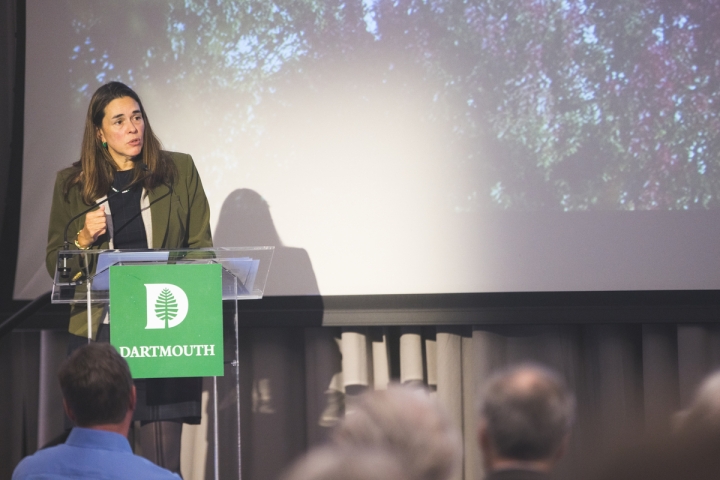“Great institutions are not stagnant. Great institutions will not stay great, in a moment like this, unless they evolve,” President Sian Leah Beilock told the General Faculty on Monday, delivering her first State of the College address since taking office in June.
More than 200 people attended the meeting in the Grand Ballroom of the Hanover Inn or watched via livestream. The General Faculty is made up of the Faculty of Arts and Sciences and the faculties of Geisel School of Medicine, Thayer School of Engineering, and Tuck School of Business. The arts and sciences faculty serves both the undergraduate College and the Guarini School of Graduate and Advanced Studies.
Beilock thanked the faculty for what she described as hundreds of one-on-one conversations in recent months, as well as larger meetings with professors by division and school. These meetings have left her “in awe of the talent and caliber of people we have in this faculty,” she said.
“You are the ones, year after year, who serve as the enduring, lasting examples of what Dartmouth is all about. So as we talk about this journey ahead of us, I see it as a true partnership.”
Building on the vision laid out at her Inauguration last month—for mental health and wellness, brave spaces, sustainability, lifelong community, and innovation and impact—Beilock described how she envisions pushing Dartmouth to the next level at a time when the institution, and higher ed as a whole, is at an inflection point.
“I want to talk about being connected. I want to talk about being strategic. And I want to talk about being creative,” she said.
Being connected means recognizing that Dartmouth is “more than the sum of our parts,” Beilock said.
To that end, she said, she has begun taking an active role with the Council on Institutional Priorities, a cross-institutional faculty committee; has created a new senior position for a chief health and wellness officer; is preparing to roll out a strategic plan for student mental health and wellness; and is making major investments in housing and child care.
In addition, Beilock announced the next stage of the Arts and Sciences Future project launched by then-President Philip J. Hanlon in 2022 to explore new organizational and budget models for the Arts and Sciences. Provost David Kotz ’86 and Nina Pavcnik, the Niehaus Family Professor in International Studies and a professor of economics, will build “on the fantastic momentum of Dean Elizabeth Smith, to help us think about how we can assemble the organizational and budget structures that not only centers the arts and sciences at Dartmouth, but gives faculty a strong voice, and makes clear how we can better collaborate across schools,” Beilock said.
Town hall meetings to discuss the Arts and Sciences Future project are set for next week with an in-person session on Monday at 5:15 p.m. at the Hanover Inn and a virtual town hall by Zoom the next day, at 3:15 p.m.
“This is doubling down on what it means to do a liberal arts education at its best—and how we can think in new and creative ways about connecting the liberal arts to the expertise in the graduate and professional schools,” Beilock said.
Dartmouth’s scale requires the institution to think and act strategically, Beilock said.
“If we act strategically across the board—in our investments, our advancement work, our admissions, everywhere—there is a great multiplier effect that occurs. And that’s exactly what I want us to do: To be smart. To pick our lanes thoughtfully.”
Dartmouth is currently positioned to take advantage of a strong balance sheet to make investments in “historic areas of underinvestment, like housing and energy,” and to develop a holistic approach to admissions that lives up to institutional values of diversity that are “vital to creating the kind of community we want to be,” she said.
Finally, Beilock called for renewed creativity “in reshaping what the best education looks like,” such as piloting collaborations across schools and divisions and expanding Dartmouth’s reach to new demographics.
“The more creative we become, the more we’ll see benefits reach across the institution,” she said.
“All of the pieces are here. We can be leading. We should be leading. And if we work together, I believe we will be leading,” she said. “I know we’ll continue to do great things together.”

